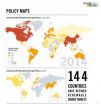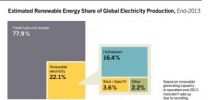(Press-News.org) The number of emerging economy nations with policies in place to support the expansion of renewable energy has surged more than six-fold in just eight years, from 15 developing countries in 2005 to 95 early this year.
Those 95 developing nations today make up the vast majority of the 144 countries with renewable energy support policies and targets in place, says REN21's Renewables 2014 Global Status Report. And the rise of developing world support contrasts with declining support and renewables policy uncertainty and even retroactive support reductions in some European countries and the United States.
Launched at the UN-hosted Sustainable Energy for All in New York, the 2014 report credits support policies with a central role in driving global renewable energy capacity to a new record level last year — 1,560 gigawatts (GW), up 8.3% from 2012. More than one-fifth — 22% — of the world's power production now comes from renewable sources.
According to REN21: "Markets, manufacturing, and investment expanded further across the developing world, clearly illustrating that renewables are no longer dependent upon a small handful of countries."
In 2013, an estimated 6.5 million people worldwide worked directly or indirectly in the renewable energy sector.
Available publicly from June 4 (http://www.ren21.net/gsr), REN21's Renewables 2014 Global Status Report is the world's most frequently-referenced report on the renewable energy market, industry and policy developments.
Among highlights:
Overall last year, renewables accounted for more than 56% of net additions to global power capacity.
Hydropower rose by 4% to approximately 1,000 GW in 2013, accounting for about one-third of renewable power capacity added during the year. Other renewables collectively grew nearly 17% to an estimated 560 GW.
Renewable energy provided 19% of global final energy consumption in 2012, and continued to grow in 2013. Of this total share in 2012, modern renewables accounted for 10% with the remaining 9% coming from traditional biomass the share of which is declining.
Useful heat energy from modern renewable sources accounted for an estimated 4.2% of total final energy use; hydropower made up about 3.8%, and an estimated 2% was provided by power from wind, solar, geothermal, and biomass, as well as by biofuels.
For the first time, more solar PV than wind power capacity was added worldwide, accounting for about one-third of renewable power capacity added during the year.
Even as global investment in solar PV declined nearly 22% relative to 2012, new capacity installations increased by more than 32%. The solar PV market had a record year, adding more than 39 GW in 2013 for a total of approximately 139 GW. China saw spectacular growth, accounting for nearly one third of global capacity added, followed by Japan and the United States.
China, the United States, Brazil, Canada, and Germany remained the top countries for total installed renewable power capacity.
China's new renewable power capacity surpassed new fossil fuel and nuclear capacity for the first time.
In the European Union, 2013 marked the sixth consecutive year in which renewables represented the majority of new electricity generating capacity. The 72% share in 2013 is in stark contrast to a decade earlier, when conventional fossil generation accounted for 80% of new capacity in the EU-27 plus Norway and Switzerland.
Renewables are achieving high levels of penetration in several countries. For example, throughout 2013, wind power met 33.2% and 20.9% of electricity demand in Denmark and Spain, respectively; in Italy, solar PV met 7.8% of total annual electricity demand.
Growing numbers of cities, states, and regions seek to transition to 100% renewable energy in either individual sectors or economy-wide. For example, Djibouti, Scotland, and the small-island state of Tuvalu aim to derive 100% of their electricity from renewable sources by 2020. Among those whom have already achieved their goals are about 20 million Germans who live in so-called 100% renewable energy regions.
Uruguay, Mauritius, and Costa Rica were among the top countries for investment in new renewable power and fuels relative to annual GDP.
Wind power was excluded from one of Brazil's national auctions because it was pricing all other generation sources out of the market.
More than 35 GW of wind power capacity was added in 2013, totalling just more than 318 GW. However, despite several record years, the market was down nearly 10 GW compared to 2012, reflecting primarily a steep drop in the U.S. market. Offshore wind had a record year, with 1.6 GW added, almost all of it in the EU.
Heating and cooling from modern biomass, solar, and geothermal sources account for a small but gradually rising share of final global heat demand, amounting to an estimated 10%.
Denmark banned the use of fossil fuel-fired boilers in new buildings as of 2013 and aims for renewables to provide almost 40% of total heat supply by 2020.
Robust policies coupled with continuing technological advances, falling prices, and innovations in financing have made renewables increasingly affordable for a broader range of consumers worldwide. Global new investment in renewable power and fuels was at least USD 249.4 billion in 2013 down from its record level in 2011.
REN21's 2014 report says policy mechanisms continue to evolve. In 2013, feed-in policies in many countries shifted towards premium payments in the power sector, and continued to be adapted for use in the heating sector. New policies advanced or managed the integration of high shares of renewable electricity into existing power systems, including support for energy storage, demand-side management, and smart grid technologies.
"Global perceptions of renewable energy have shifted considerably," says Arthouros Zervos, Chair of REN21.
"Over the last 10 years, continuing technology advances and rapid deployment of many renewable energy technologies have demonstrated that the question is no longer whether renewables have a role to play in the provision of energy services, but rather how we can best increase the current pace to achieve a 100% renewables future with full energy access for all."
"For this to be become reality, current thinking needs to change: continuing the status quo of a patchwork of policies and actions is no longer sufficient. Instead, technology developments, finance models as well as stable and predictable renewable energy policies need to be systematically linked across the public and private sectors in order to support and drive the transition process."
Says Christine Lins, Executive Secretary, REN21: "The past decade has set the wheels in motion for a global transition to renewables, but a concerted and sustained effort is needed to achieve it. With increasingly ambitious targets and innovative policies, renewables can continue to surpass expectations and create a clean energy future."
INFORMATION:
About the REN21 Renewables Global Status Report
First released in 2005, the annual Renewables Global Status Report provides a comprehensive and timely overview of renewable energy markets, industries, investments, and policy developments worldwide. It enables policymakers, industry, investors, and civil society to make informed decisions.
The report covers recent developments, current status, and key trends on all renewable technologies and end-use sectors. By design, it does not provide analysis or forecast.
The Renewables Global Status Report relies on up-to-date renewable energy data, provided by an international network of more than 500 contributors, researchers, and authors.
With developing world's policy support, global renewable energy generation capacity jumps to record
Now 95 emerging economies nurture renewable energy growth through supportive policies, up six-fold from just 15 countries in 2005
2014-06-03
ELSE PRESS RELEASES FROM THIS DATE:
Liver cancer vaccine effective in mice
2014-06-03
AUGUSTA, Ga. – Tweaking a protein expressed by most liver cancer cells has enabled scientists to make a vaccine that is exceedingly effective at preventing the disease in mice.
Alpha-Fetoprotein, or AFP – normally expressed during development and by liver cancer cells as well – has escaped attack in previous vaccine iterations because the body recognizes it as "self," said Dr. Yukai He, immunologist at the Medical College of Georgia and Georgia Regents University Cancer Center.
Liver cancer is among the fastest-growing and deadliest cancers in the United States with ...
Spiders know the meaning of web music
2014-06-03
Spider silk transmits vibrations across a wide range of frequencies so that, when plucked like a guitar string, its sound carries information about prey, mates, and even the structural integrity of a web.
The discovery was made by researchers from the Universities of Oxford, Strathclyde, and Sheffield who fired bullets and lasers at spider silk to study how it vibrates. They found that, uniquely, when compared to other materials, spider silk can be tuned to a wide range of harmonics. The findings, to be reported in the journal Advanced Materials, not only reveal more ...
'Liquid biopsy' offers new way to track lung cancer
2014-06-03
Scientists have shown how a lung cancer patient's blood sample could be used to monitor and predict their response to treatment – paving the way for personalised medicine for the disease.
The recent study, published in the journal Nature Medicine, also offers a method to test new therapies in the lab and to better understand how tumours become resistant to drugs.
Small cell lung cancer (SCLC) is an aggressive disease with poor survival and new treatments are desperately needed. In many cases the tumour is inoperable and biopsies are difficult to obtain, giving scientists ...
New insight into drug resistance in metastatic melanoma
2014-06-03
A study by scientists in Manchester has shown how melanoma drugs can cause the cancer to progress once a patient has stopped responding to treatment.
Their findings suggest that using a combination of targeted therapies may be a more effective approach in the clinic.
Melanoma is a form of cancer that develops from melanocytes – the pigment-producing cells in skin. Advanced metastatic melanoma – where the cancer has spread throughout the body – is associated with poor survival, so new treatments are urgently needed.
In about 50% of melanoma cases, the tumour contains ...
Notifying speeding mariners lowers ship speeds in areas with North Atlantic right whales
2014-06-03
There are only around 500 North Atlantic right whales alive today. In an effort to further protect these critically endangered animals, a recent NOAA regulation required large vessels to reduce speed in areas seasonally occupied by the whales. The policy of notifying--but not necessarily citing--speeding vessels in protected areas was effective in lowering their speeds, helping to protect these magnificent creatures from ship collisions, while keeping punitive fines to mariners to a minimum.
A NOAA regulation, instituted in December 2008, requires vessels 65 feet or greater ...
Findings show benefit of changing measure of kidney disease progression
2014-06-03
Developing therapies for kidney disease can be made faster by adopting a new, more sensitive definition of kidney disease progression, according to a study published by JAMA. The study is being released early online to coincide with its presentation at the European Renal Association-European Dialysis and Transplant Association Congress.
Chronic kidney disease (CKD) is a worldwide public health problem, with increasing prevalence, poor outcomes, and high treatment cost. Yet, despite the avail¬ability of simple laboratory tests to identify people with earlier stages of ...
Columbia Nursing study exposes infection risks in home health
2014-06-03
(NEW YORK, NY, June 3, 2014) – Millions of Americans depend on home health care services to recover from surgeries and hospital stays, as well as to manage daily life with chronic conditions. But all too often, evidence-based practices for preventing infections aren't followed when care is provided at home, leaving patients vulnerable to serious and potentially fatal complications. A study by researchers at Columbia University School of Nursing, published in the American Journal of Infection Control, found that unsterile living conditions and untrained caregivers contribute ...
Proteins 'ring like bells'
2014-06-03
As far back as 1948, Erwin Schrödinger—the inventor of modern quantum mechanics—published the book "What is life?"
In it, he suggested that quantum mechanics and coherent ringing might be at the basis of all biochemical reactions. At the time, this idea never found wide acceptance because it was generally assumed that vibrations in protein molecules would be too rapidly damped.
Now, scientists at the University of Glasgow have proven he was on the right track after all.
Using modern laser spectroscopy, the scientists have been able to measure the vibrational spectrum ...
Molecular 'scaffold' could hold key to new dementia treatments
2014-06-03
Researchers at King's College London have discovered how a molecular 'scaffold' which allows key parts of cells to interact, comes apart in dementia and motor neuron disease, revealing a potential new target for drug discovery.
The study, published today in Nature Communications, was funded by the UK Medical Research Council, Wellcome Trust, Alzheimer's Research UK and the Motor Neurone Disease Association.
Researchers looked at two components of cells: mitochondria, the cell 'power houses' which produce energy for the cell; and the endoplasmic reticulum (ER) which ...
Controlling thermal conductivities can improve energy storage
2014-06-03
Controlling the flow of heat through materials is important for many technologies. While materials with high and low thermal conductivities are available, materials with variable and reversible thermal conductivities are rare, and other than high pressure experiments, only small reversible modulations in thermal conductivities have been reported.
For the first time, researchers at the University of Illinois at Urbana-Champaign have experimentally shown that the thermal conductivity of lithium cobalt oxide (LixCoO2), an important material for electrochemical energy storage, ...
LAST 30 PRESS RELEASES:
Scalable and healable gradient textiles for multi‑scenario radiative cooling via bicomponent blow spinning
Research shows informed traders never let a good climate crisis go to waste
Intelligent XGBoost framework enhances asphalt pavement skid resistance assessment
Dual-function biomaterials for postoperative osteosarcoma: Tumor suppression and bone regeneration
New framework reveals where transport emissions concentrate in Singapore
NTP-enhanced lattice oxygen activation in Ce-Co catalysts for low-temperature soot combustion
Synergistic interface engineering in Cu-Zn-Ce catalysts for efficient CO2 hydrogenation to methanol
COVID-19 leaves a lasting mark on the human brain
Scientists use ultrasound to soften and treat cancer tumors without damaging healthy tissue
Community swimming program for Black youth boosts skills, sense of belonging, study finds
Specific depressive symptoms in midlife linked to increased dementia risk
An ‘illuminating’ design sheds light on cholesterol
Who is more likely to get long COVID?
Study showcases resilience and rapid growth of “living rocks”
Naval Research Lab diver earns Office of Naval Research 2025 Sailor of the Year
New Mayo-led study establishes practical definition for rapidly progressive dementia
Fossil fuel industry’s “climate false solutions” reinforce its power and aggravate environmental injustice
Researchers reveal bias in a widely used measure of algorithm performance
Alcohol causes cancer. A study from IOCB Prague confirms damage to DNA and shows how cells defend against it
Hidden viruses in wastewater treatment may shape public health risks, study finds
Unlock the power of nature: how biomass can transform climate mitigation
Biochar reshapes hidden soil microbes that capture carbon dioxide in farmland
Reducing saturated fat intake shows mortality benefit, but only in high-risk individuals
Manta rays create mobile ecosystems, study finds
Study: Mixed results in using lipoic acid to treat progressive multiple sclerosis
Norbert Holtkamp appointed director of Fermi National Accelerator Laboratory
New agentic AI platform accelerates advanced optics design
Biologists discover neurons use physical signals — not electricity — to stabilize communication
Researchers discover that a hormone can access the brain by hitchhiking
University of Oklahoma researcher awarded funding to pursue AI-powered material design
[Press-News.org] With developing world's policy support, global renewable energy generation capacity jumps to recordNow 95 emerging economies nurture renewable energy growth through supportive policies, up six-fold from just 15 countries in 2005






